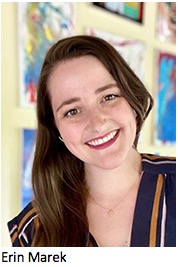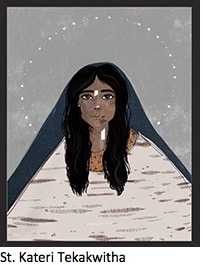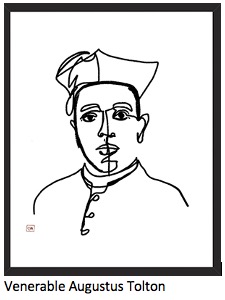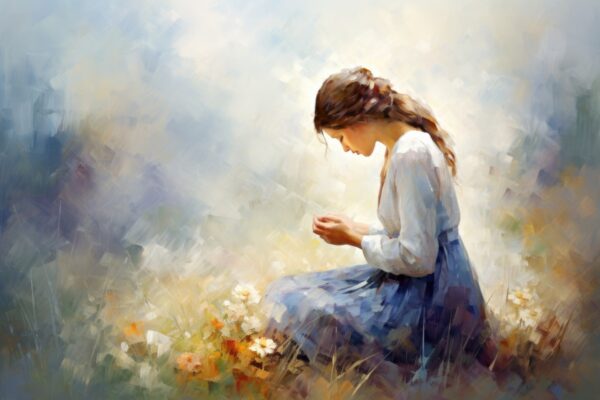This is the first in a three-part series interviewing Catholic female creators of sacred art.
 Erin Marek believes she has two complementary vocations: the first as a wife and mother, and the second as an artist.
Erin Marek believes she has two complementary vocations: the first as a wife and mother, and the second as an artist.
A wife and mom of four young children, Marek is an artist and maker living in southern Ohio. She has a degree from the School of the Museum of Fine Arts, Boston and Tufts University and has also studied at the Art Students League of New York. What started as a desire to find modern sacred art for her family led Marek to create a series of saint portraits, including Venerable Father Tolton, St. Kateri and St. Edith Stein.
During Radiant’s conversation with Marek, she shared her creative process, such as how she chooses certain saints and how to portray them as real people instead of “ethereal caricatures of themselves.”
Radiant: What began your journey as an artist?
Erin Marek: I have a high school memory of my mom saying something along the lines of, “I don’t always understand why or what you’re making, but you are definitely committed.” My dad always took the time to really look at my work and ask thoughtful questions about my choices of color or imagery. Little moments like those had an impact on me and made me feel like pursuing art was a real option. I was homeschooled from fifth grade through high school but was able to take two art courses every semester at the public school. I read about art and artists, experimented in all kinds of mediums, and made a whole lot of terrible art before I made anything decent. I think that last bit is key. Give yourself permission to be less than perfect, and keep improving your skills. Love for your craft is important, but you consistently have to put in the work.
Radiant: What prompted you to create sacred art?
Marek: A few years ago, I was looking for a gift for my younger sister. I had an idea of what I was looking for — a soft saint doll — but couldn’t find it anywhere in the style I wanted. So, I made it. It turned out other people responded to that style also, and largely through word of mouth. In a similar way, I was looking to buy portraits of our family patron saints and couldn’t find a style that really spoke to me, so I drew my own! I never envisioned using my artistic skills in this way, but the Holy Spirit often moves in ways I least expect.
Radiant: What are your favorite mediums to use?
Marek: Much of my work has always been mixed media. I love inks, the imperfect-ness of monoprint, the texture of handmade paper collage or sculpted plaster. I am a mom of four young children, and the cleanup process for both sewing and digital work is simple, and I can stop and start easily. I do have dreams of setting up a print studio and getting back to analog work in the future. Artists know there’s nothing that compares to the smell of fresh ink!
Radiant: What does your art process look like?
Marek: I’m constantly drawing, or jotting down ideas. In drawing modern saints, there are some photographs to work from. When drawing older saints, I collect a lot of reference photos, keeping in mind the ancestry and birthplace of each particular saint. When I begin a drawing session, I often start with the eyes. Our facial features, and to me the eyes in particular, are a unique part of our individual dignity. It always blows my mind to realize that every freckle, wrinkle, and eyelash was created by God with intention.
Radiant: Where does your inspiration come from?
Marek: The universal nature of the Church inspires me, and the fact that at any given time across the globe there is someone in the act of worship in the Catholic tradition. My favorites to read about are those that are lesser known, at least in my own part of the world. If we can see parts of our own stories reflected in the lives of St. Joan, St. Kateri or Venerable Fr. Augustus Tolton, then we can be encouraged to also live our individual paths to holiness.
Radiant: What artists or pieces of artwork have shaped your own style?
Marek: I always thought Van Gogh was overrated until I sat in front of one of his landscapes at the Met in New York and was moved to tears. I think the real calling of an artist is, if I can paraphrase the great St. John Paul II, to stir souls to wonder and give them the chance to encounter beauty.
I’m also deeply influenced by artists who are unknown — the monks who quietly created illuminated manuscripts such as the Book of Kells, sculptors and stone masons who labored to build grand cathedrals, and the unnamed authors of ancient icons and mosaics. Their hands created incredible art that has survived centuries not for the recognition, but as an act of praise.
Radiant: Who is one of your favorite saints and why?
Marek: My adopted patron saint is Columbkille (Columba). He’s known as one of the Apostles of Ireland and the patron saint of bookmakers. Another favorite is St. Josephine Bakhita. I had heard of her soon after her canonization in the early 2000s and was immediately struck by her story of radical forgiveness. Here is a woman, kidnapped as a child and sold into slavery, so traumatized that she forgets her own name. Unimaginable torture was inflicted upon her for years, and when she finally fights and gains her rightful freedom, she is quoted as giving thanks to her captors as they were the reason she started the journey that would lead her to know Jesus Christ. How easy it is to be bitter about our circumstances, yet she chose joy, love and forgiveness.
Radiant: As a mom, how do you find time for integrating your passion for creating into day to day life? What kinds of sacrifices have you had to make in order to pursue art?
Marek: I have not yet figured out how to add more hours into the day, and I certainly sleep less than I’d like to. It’s a team effort. My husband, Don, has been a great cheering section. If I need time to work at night, he’s awesome at baby snuggling so I can work. During the day I carve out the time where I can. And to be realistic, there are some seasons of our lives where the time for artwork just isn’t there, and I have to be okay with that, too. I consider that I have two complementary vocations — a wife and mother, and an artist. They can work together, but family life always has to come first. It’s my hope that having our kids see their parents continue to pursue their passions and improve the talents God has gifted us with can be an important lesson for them as they grow and find their own gifts.
Radiant: Did you experiment with a lot of different mediums during your time in art school?
Marek: My art studies began in earnest when I spent two semesters in Manhattan studying figurative sculpture and casting techniques. When I moved to attend the School of The Museum of Fine Arts, Boston (SMFA), I started with sculpture as my focus. The program didn’t require a declared major, and we were encouraged to find a focus but take classes in all disciplines. I quickly fell in love with papermaking and book arts, and by extension printmaking.
Radiant: Can you share with me some of the fun, hidden details you have in some of your drawings?

Marek: In my newer Kateri piece, I gave her clothing the birch bark pattern as a nod to the Mohawk way of life, as they and other Native American tribes in the northeast used this material in their daily lives. I overlaid an image of the Milky Way in her veil, both because she is known as a patron of the environment and also because she wore the cloth over her head to protect her damaged eyesight from harsh sunlight. I imagine that the night may have been more comfortable for her.
In the Edith Stein drawing, you’ll find an image from an antique bible written in Hebrew as well as a city storefront in Breslau, Germany, in parts of her clothing. This was significant because she has always seemed to be able to navigate between two often competing worlds — being born into a Jewish family and later converting to Catholicism, being a woman in academic circles at a time when women were allowed to study at university yet not allowed to become professors, and having been born in a city, Breslau, that would change its name and country after the war. Little details are important to me because they ground the saints in reality and help me connect to them on a personal level. It can be easy to treat the saints as these ethereal caricatures of themselves and forget that they were both highly in tune with the spiritual and also real human beings, living and breathing in our beautiful and broken world.
 Radiant: Can you tell me a little bit about Venerable Augustus Tolton and why you wanted to share his story with the world?
Radiant: Can you tell me a little bit about Venerable Augustus Tolton and why you wanted to share his story with the world?
Marek: I first came across the story of Venerable Father Tolton a few years ago when I was researching American-born Catholics that are on the road to sainthood. Father Tolton had a deep commitment to God’s call, in the face of harsh and lasting opposition. He was born into an enslaved family in 1854 in the American South who were owned by a Catholic family, and named after the great St. Augustine. When he was a child, they fled to freedom in Illinois, enduring harassment and active racism even from the church community they joined there. He felt a call to the priesthood and, despite the support of his parish priest, was rejected from every single seminary in the U.S. due to his skin color. He was forced to travel abroad to study and become ordained.
Augustus had the support of his local pastor, but I don’t think it’s wrong to imagine many other young black men and women may have heard that invitation from God but were actively discouraged or lacked the support to fully realize their vocation. I think our Church is certainly a lesser community because of their absence. The Church clearly teaches that all souls have equal dignity, having been created in the image of God, though some of her members have not always upheld this teaching. We have to recognize that these injustices are a part of our history as members of the Body of Christ, and that it’s recent history that still reverberates today. Venerable Augustus Tolton can be a powerful intercessor for the Church and the world in this moment. I pray we will soon be asking for his prayers as a canonized saint.
You can follow Erin Marek on Instagram @marekmade and find her artwork on her website, Marek Made.




